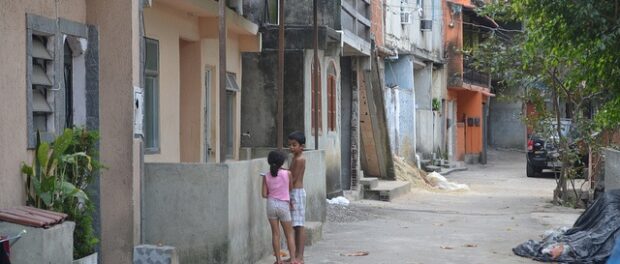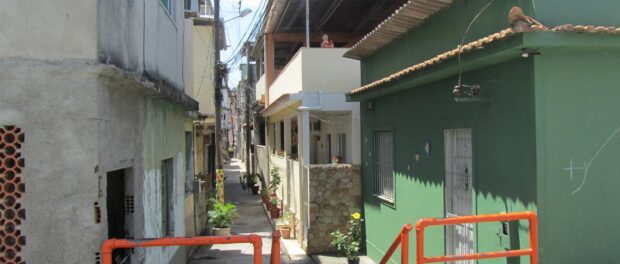
This is the final article in a four-part series on the potential to apply the Community Land Trust (CLT) model under existing Brazilian laws to secure land rights in Brazil’s favelas. The series was written for a Brazilian audience and summarizes and adapts a report by lawyer and urban planner Tarcyla Fidalgo, prepared with the support of the Lincoln Institute of Land Policy (LILP). It clarifies several aspects of the proposal, showing the foundations of the CLT model; adapting the model to favelas; and explaining its benefits, applicability, and ways of functioning. In this fourth part, we show how land could be acquired to form a Community Land Trust in Brazilian favelas based on existing legal instruments.
The publication of this series follows five days of workshops (from August 23-27) with a delegation from Puerto Rico, whose members successfully implemented a CLT in eight informal settlements along the Caño Martín Peña in San Juan with excellent results. The workshops were carried out by Catalytic Communities* in partnership with the Rio de Janeiro State Public Defender’s Office, Pastoral de Favelas, the Architecture and Urbanism Council of Rio de Janeiro (CAU/RJ), and the Laboratory for Studies of Transformations in Brazilian Urban Law (LEDUB).
Land Acquisition
In Brazil, access to land is a significant challenge. In the case of favelas, this situation is even more complicated in the context of widespread land irregularity (in terms of titling and compliance with urban planning regulations), which makes the land acquisition process difficult. This is, therefore, one of the principal challenges to forming a Favela Community Land Trust. While the CLT is premised on collective land ownership and management, the surface rights and many buildings constructed on its land remain private. Therefore, it is not possible to speak of the full implementation of this model without land regularization.
Land Regularization
Land regularization is a highly sought-after legal procedure by favela residents and institutions that provide legal support to this population. Though it can be quite controversial—especially when applied by way of individual titling, thus facilitating the direct entry of titled areas into the formal and highly speculative real estate market—land titling is a necessary step to implement a CLT, which seeks to guarantee the rights and tenure security of vulnerable residents.
In the case of creating a Favela Community Land Trust, land regularization is necessary to facilitate land acquisition by the legal person created to manage the CLT (see Part 3 of this series), and in this way, guarantee the permanence of residents on that land, while conferring the ownership of buildings to residents. Creating a Favela CLT can take place in one of two ways:
- Once they have been individually titled, residents transfer their land to the legal person created (the Community Land Trust). In other words, the transfer of land ownership follows the individual titling process, which could take place via purchase and sale or donation. However, in this case, it is highly recommended that the legal person be created in advance and that residents determine how the CLT will work prior to receiving land titles. This is to ensure that residents are clear on what they want and agree on their mutual intentions to join together as a CLT from the outset.
- A direct donation of land can be made to the CLT, in which case it is first necessary to create a legal person to which the donated land will be transferred so that the regularization process can take place directly with this legal person.
Concession of Use Rights, Adverse Possession, and Land Tenure Legitimation
In favelas, the most common forms of land regularization are either (1) via the concession of use rights (in the case of public land), or (2) via individual or collective adverse possession (in the case of private land).
Currently, favelas on public land are regularized largely via concession of use or adverse possession. In the case of regularizing public land, the Real Concession of Use and Special Concession of Use for Housing Purposes are utilized. The difference between the two lies in the prospect of applicability and in the requirements to be fulfilled by residents. However, in either case a permanent concession of use is not an existing option (leases are usually for 99 years or some other timeframe) and therefore this would not be an appropriate option for the creation of a Favela Community Land Trust.
In the case of private land, regularization can be carried out via individual or collective adverse possession. With a reduced period of property possession (five years), the requirements for urban adverse possession are less rigid but the area in possession is limited to 250 square meters. In the case of collective adverse possession, upon proving the impossibility of dividing the area into individual parcels, residents are given property titles for ideal portions of the total area. In either case, adverse possession confers beneficiaries with full individual property titles, accompanied by the challenge of guaranteeing that residents are able to remain in these areas in the face of real estate market activity.
Beyond the previous options described above of titling via concession of use on public land or adverse possession on private land, there is now an additional possibility available to favela residents for land regularization. In July 2017 a new instrument known as land tenure legitimation was introduced by the controversial Law 13.465. This instrument permits individual titling of individual residents who live in informal urban areas that were already in existence prior to December 22, 2016, via full private ownership. Without greater restrictions on the period of occupation or documentation thereof, this new instrument imposes requires that: (i) the beneficiary does not own another property, (ii) there is no other title issued through land tenure legitimation, and that (iii) in the case of a property utilized for carrying out economic activities, its public interest is recognized by the administration. With this short list of requirements, the instrument posits itself as a great asset for public entities seeking to quickly and inexpensively promote regularization. This new law thus incentivizes the regularization of public land via unrestricted full individual titling (not a concession of use based on a set timeframe as was historically applied on public land), potentially encouraging real estate speculation and the concentration of land ownership.
In facilitating land regularization in general, the new law also facilitates regularization processes for favela residents, which currently take considerable time. What could this mean? In the case of favelas, the possibility of inserting mass amounts of public land into the speculative real estate market is alarming given favelas’ role in guaranteeing an affordable real estate market. Another risk involves the law’s relief of public responsibility to promote upgrading and building safety measures for regularization. The concern is that the instrument promotes the mass delivery of titles without any regard for improving residents’ quality of life or guaranteeing their ability to remain in the territory. However, in the absence of reforms to the new law, and so long as specific legislation for Community Land Trusts is nonexistent, establishing Favela CLTs by way of residents’ pooling their titles once given could serve as a way of circumventing this problematic scenario, guaranteeing residents’ tenure security and maintaining strong community organizing and ties, by withdrawing their land from the speculative market.
Beyond these instruments, there are still other options to promote land regularization in a way conducive to the necessary conditions for creating a CLT—namely, purchase and sale, and donation.
Purchase and Sale
An additional option for the CLT to obtain land is through a traditional purchase and sale contract between private parties. In this case, one of the parties would be the legal person created in advance to manage the CLT. However, the major challenge of this option is obtaining resources for land acquisition by the CLT, as the costs of such a transaction could be high depending on the area acquired and the taxes levied on it.
Another possibility is obtaining land through purchase and sale involving private parties and public entities. In cases of social interest, certain requirements can be removed, such as the preliminary assessment of the land, or a competitive bidding process which would typically slow things down.
Donation
Donation can be applied in cases involving private or public land, though the latter is more common in favelas. Civil law applies if the donor is a private party, whereas administrative law applies in the case of public entities. It is important to highlight that taxes levied on donations fall under state jurisdiction.
In the case of a Favela Community Land Trust, the land could be donated by a public institution or by a private party. It would be necessary for the legal person of the Community Land Trust to be created in advance in order to receive the land.
Instruments to Facilitate the Community Land Trust
At this point, we will elaborate on some options of existing Brazilian legal instruments that make it possible to separate the ownership of land (which is collective and permanent) from that of housing (which is individual and transferable) in order to guarantee the primary feature of a Community Land Trust.
Surface Rights
Surface rights refer to a legal instrument established in the Brazilian Civil Code and in the City Statute that permits the separation of land ownership from the ownership of buildings constructed on that land. In this case, surface rights allow for buildings to be individually owned, even while the land itself is public or belongs to another person, which is aligned with the CLT model. Buildings can be preexisting or subsequently constructed on the land.
Charges and taxes are levied over the property, but in the case of a CLT, payment could be agreed upon between the parties (including in such a way that residents would not be responsible for these fees). Another characteristic of this instrument—appropriate for CLTs—is that surface rights can be transferred to third parties. As such, the instrument does not complicate potential building transactions in which there are alterations or changes to beneficiaries. In these cases, the buildings within the CLT can be transferred to other people as desired by the property owner.
Commodatum
A commodatum is a gratuitous loan of individualized items with the expectation of subsequent restitution. A commodatum is issued through a unilateral agreement in which one party delivers a tangible or intangible asset or item for use by the recipient over a defined or undefined period. (However, the item should be returned to the original party at some point.) In terms of tax structures, this is a cost-free solution for a Favela Community Land Trust.
If this instrument is used for the proposed model, there should be a term of use for the property located on the collective land. Its duration, which can be long-term with the possibility of renewal, can be established either in the CLT’s administrative regulations or in the contract established by the commodatum. Therefore, theoretically, the buildings would be owned by the CLT, which would lend them to residents—allowing for individual residences on collective land. However, if this instrument is used for the CLT model, internal regulations would be necessary to resolve specific questions, such as the possibility of altering the recipient of the commodatum in the case of property transfer.
Possible Support: Zones of Special Social Interest
Zones of Special Social Interest (ZEIS) are Brazilian legal instruments that allow local zoning ordinances to establish unique urban planning regulations and specific property uses (contemplating a site’s social function) for particular favelas, through an individualized upgrading plan. This instrument are applied in both occupied and unoccupied areas of the city that are intended for affordable housing. For this reason, this instrument is characterized by an inherent contradiction: the flexibilization of urban planning regulations for ZEIS makes it possible to alter the minimum acceptable standards for individuals’ well-being, institutionalizing distinct minimum standards for different areas of the city, as well as establishing territorial enclaves intended for low-income populations. On the other hand, the demarcation of these areas of social interest in the territory allows these populations to remain in urban areas even as they become subject to speculative interests.
ZEIS also involves demarcating areas that should receive public investment for upgrading works, infrastructure provision, and urban and social improvements. However, ZEIS designation in itself does not guarantee these benefits. In this case, an articulation between ZEIS and Community Land Trusts could offer the potential for complementarity in striving for tenure security, increased urban infrastructure, and the adaptability of the built environment for residents’ well-being and safety. The objectives of these two instruments are similar and the CLT’s management could unite social force with technical support to achieve these goals.
Furthermore, it’s necessary for there to be an articulation between municipal authorities and the local population when a ZEIS is established. This opens up a conduit for voicing social, urban, and environmental development demands for the region. Implementing a Favela Community Land Trust in conjunction with the establishment of a ZEIS in the area would more effectively further the objectives of guaranteeing residents’ tenure security and pursuing territorial improvements.
This is the final article in a four-part series.
*RioOnWatch is a project of the NGO Catalytic Communities



